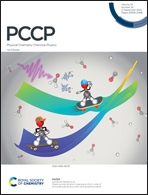Functionalized nona-silicide [Si9R3] Zintl clusters: a new class of superhalogens†
Abstract
Superatoms, due to their various applications in redox and materials chemistry, have been a major topic of study in cluster science. Superhalogens constitute a special class of superatoms that mimic the chemistry of halogens and serve as building blocks of novel materials such as super and hyper salts, perovskite-based solar cells, solid-state electrolytes, and ferroelectric materials. These applications have led to a constant search for new class of superhalogens. In this study, using density functional theory, we show that recently synthesized [Si9{Si (tBu)2H}3] and [Si9{Si (TMS)3}3] Zintl clusters not only behave like halogens but also when functionalized with suitable ligands exhibit superhalogen characteristics. Frontier molecular orbital (FMO) analyses give insights into the electron-accepting nature of the Zintl clusters. Additional bonding techniques such as energy density at the bond critical point (BCP) and adaptive natural density partitioning (AdNDP) gives complementary information about the nature of bonding in Si9-based Zintl clusters. The potential of these Zintl clusters in the synthesis of new electrolytes in Li-ion batteries is also investigated.
![Graphical abstract: Functionalized nona-silicide [Si9R3] Zintl clusters: a new class of superhalogens](/en/Image/Get?imageInfo.ImageType=GA&imageInfo.ImageIdentifier.ManuscriptID=D2CP02619H&imageInfo.ImageIdentifier.Year=2022)
- This article is part of the themed collection: #RSCPoster Conference


 Please wait while we load your content...
Please wait while we load your content...